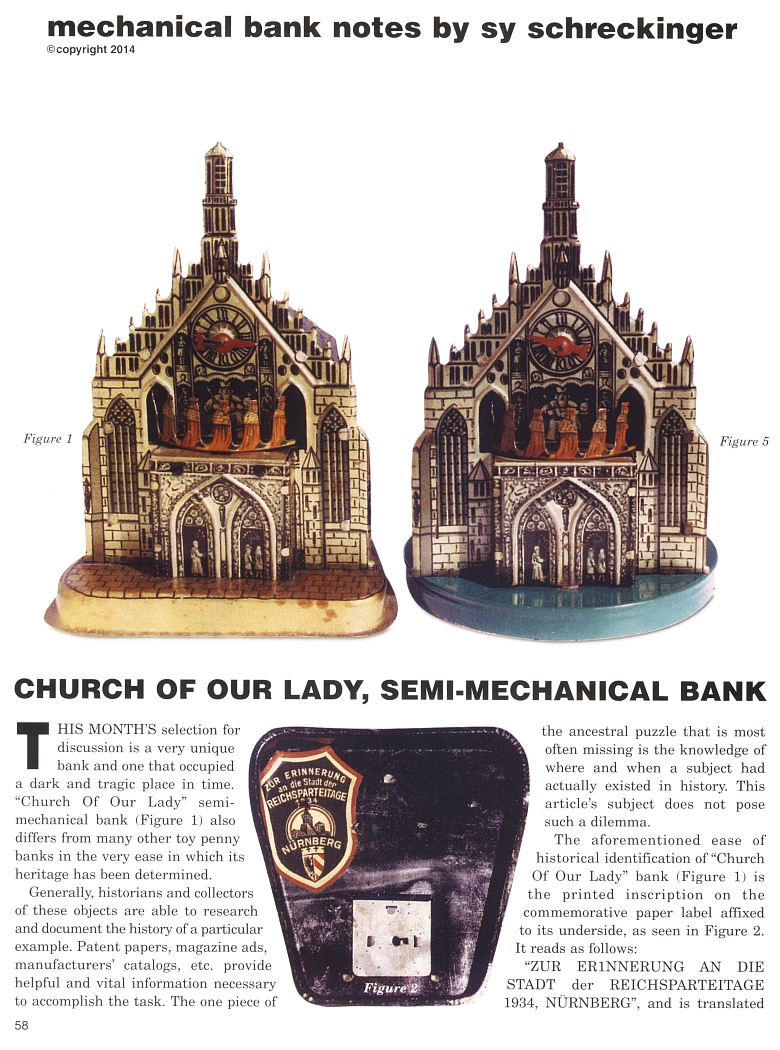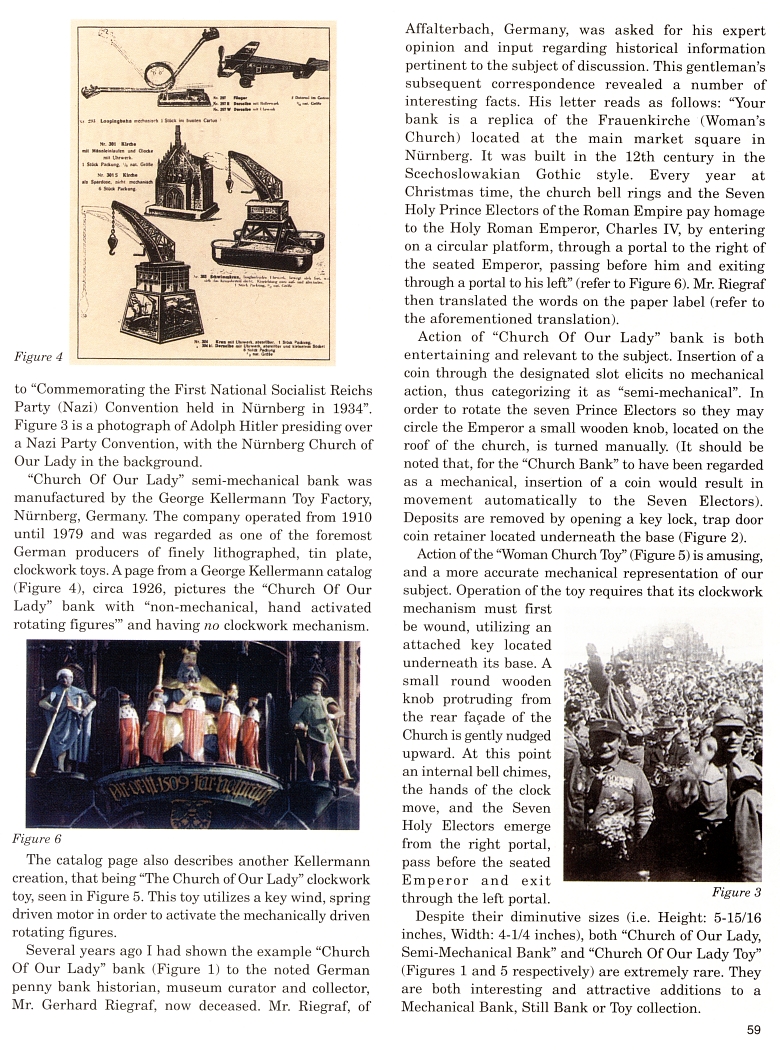|
Church of Our Lady,
Semi-mechanical Bank
by Sy Schreckinger – ANTIQUE TOY WORLD Magazine – May, 2014
THIS MONTH'S selection for discussion is a very unique bank and one that
occupied a dark and tragic place in time. "Church Of Our Lady" semi-
mechanical bank (Figure 1) also differs from many other toy penny banks
in the very ease in which its heritage has been determined.
Generally, historians and collectors of these objects are able to
research and document the history of a particular example. Patent
papers, magazine ads, manufacturers' catalogs, etc. provide helpful and
vital information necessary to accomplish the task. The one piece of the
ancestral puzzle that is most often missing is the knowledge of where
and when a subject had actually existed in history. This article's
subject does not pose such a dilemma.
The aforementioned ease of historical identification of "Church Of
Our Lady" bank (Figure 1) is the printed inscription on the
commemorative paper label affixed
to its underside, as seen in Figure 2. It reads as follows:
"ZUR ER I NNERUNG AN DIE STADT der REICHSPARTEITAGE 1934, NURNBERG", and
is translated to "Commemorating the First National Socialist Reichs
Party (Nazi) Convention held in Nurnberg in 1934". Figure 3 is a
photograph of Adolph Hitler presiding over a Nazi Party Convention, with
the Ntirnberg Church of Our Lady in the background.
"Church Of Our Lady" semi-mechanical bank was manufactured by the
George Kellermann Toy Factory, Nurnberg, Germany. The company operated
from 1910 until 1979 and was regarded as one of the foremost German
producers of finely lithographed, tin plate, clockwork toys. A page from
a George Kellermann catalog (Figure 4), circa 1926, pictures the "Church
Of Our Lady" bank with "non-mechanical, hand activated rotating
figures'" and having no clockwork mechanism.
The catalog page also describes another Kellermann creation, that
being "The Church of Our Lady" clockwork toy, seen in Figure 5. This toy
utilizes a key wind, spring driven motor in order to activate the
mechanically driven rotating figures.
Several years ago I had shown the example "Church Of Our Lady" bank
(Figure 1) to the noted German penny bank historian, museum curator and
collector, Mr. Gerhard Riegraf, now deceased. Mr. Riegraf, of
Affalterbach, Germany, was asked for his expert opinion and input
regarding historical information pertinent to the subject of discussion.
This gentleman's subsequent correspondence revealed a number of
interesting facts. His letter reads as follows: "Your bank is a replica
of the Frauenkirche (Woman's Church) located at the main market square
in Nurnberg. It was built in the 12th century in the Scechoslowakian
Gothic style. Every year at Christmas time, the church bell rings and
the Seven Holy Prince Electors of the Roman Empire pay homage to the
Holy Roman Emperor, Charles IV, by entering on a circular platfhrm,
through a portal to the right of the seated Emperor, passing before him
and exiting through a portal to his left" (refer to Figure 6). Mr.
Riegraf then translated the words on the paper label (refer to the
aforementioned translation).
Action of "Church Of Our Lady" bank is both entertaining and
relevant to the subject. Insertion of a coin through the designated slot
elicits no mechanical action, thus categorizing it as "semi-mechanical".
In order to rotate the seven Prince Electors so they may circle the
Emperor a small wooden knob, located on the roof of the church, is
turned manually. (It should be noted that, for the "Church Bank" to have
been regarded as a mechanical, insertion of a coin would result in
movement automatically to the Seven Electors). Deposits are removed by
opening a key lock, trap door coin retainer located underneath the base
(Figure 2).
Action of the "Woman Church Toy" (Figure 5) is amusing, and a more
accurate mechanical representation of our subject. Operation of the toy
requires that its clockwork mechanism must first be wound, utilizing an
attached key located underneath its base. A small round wooden knob
protruding from the rear facade of the Church is gently nudged upward.
At this point an internal bell chimes, the hands of the clock move, and
the Seven Holy Electors emerge from the right portal. pass before the
seated Emperor and exit through the left portal.
Despite their diminutive sizes (i.e. Height: 5-15/16 inches, Width:
4-1/4 inches), both "Church of Our Lady, Semi-Mechanical Bank" and
"Church Of Our Lady Toy" (Figures 1 and 5 respectively) are extremely
rare. They are both interesting and attractive additions to a Mechanical
Bank, Still Bank or Toy collection. |


